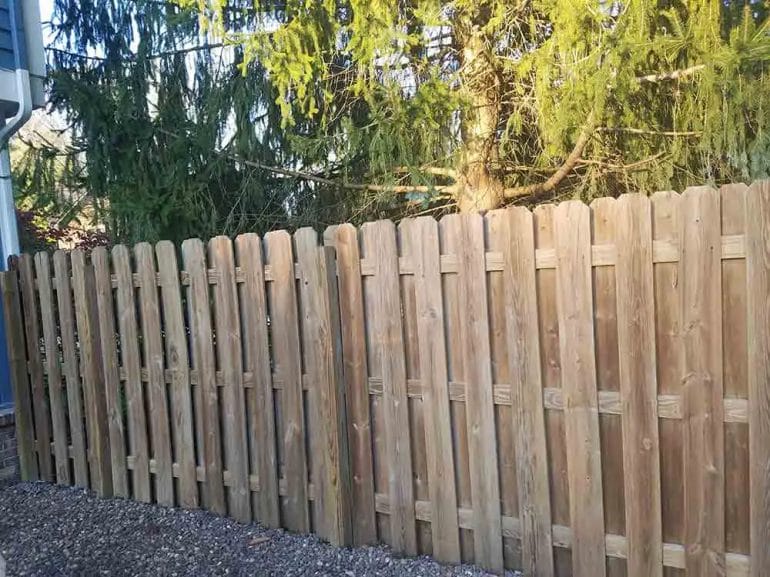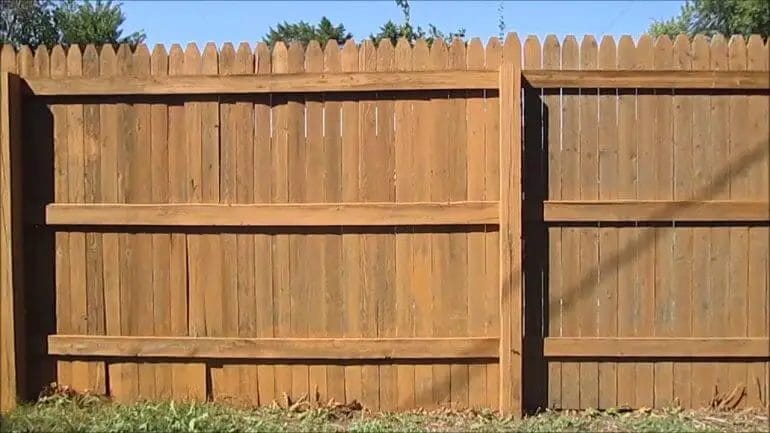Sealing a wood fence is crucial for preserving its beauty and durability. By providing a protective barrier, sealing helps prevent damage from moisture, sunlight, and other elements. Whether you have a new fence or want to revive an old one, a proper sealing process is essential. It involves cleaning the fence, repairing any damages, and applying a quality wood sealer. With the right technique, you can extend the lifespan of your wood fence and keep it looking fresh for years to come.

Step-by-Step Guide to Sealing Your Wood Fence
If you have a wood fence, it’s important to properly seal and protect it to ensure its longevity and maintain its beauty. Sealing your wood fence not only enhances its appearance, but it also helps to prevent rot, warping, and damage from the elements. In this guide, we will provide you with a step-by-step process to effectively seal your wood fence.

Step 1: Gather the necessary materials
Before you start the sealing process, make sure you have all the necessary materials at hand. This includes:
- Pressure washer or garden hose
- Mild detergent or cleaning solution
- Scrub brush or sponge
- Sandpaper
- Wood sealant or stain
- Paintbrush or roller
- Drop cloth or plastic sheeting
Step 2: Clean the fence
Start by cleaning the fence to remove any dirt, debris, or mildew. If you have a pressure washer, use it to thoroughly clean the wood. If not, a garden hose with a high-pressure nozzle will do the job. Mix a mild detergent or cleaning solution with water and scrub the fence using a brush or sponge. Rinse the fence thoroughly and allow it to dry completely before moving on to the next step.
Step 3: Sand the fence
Inspect the fence for any rough spots, splinters, or loose wood fibers. Use sandpaper to smooth out these areas and create a smooth surface for better adhesion of the sealant. Sand in the direction of the wood grain and wipe away any dust or debris before proceeding.
Step 4: Protect surrounding areas
Before applying the sealant, protect any surrounding areas, such as plants, furniture, or pathways, by covering them with a drop cloth or plastic sheeting. This will prevent any accidental staining or damage.
Step 5: Apply the sealant
Using a paintbrush or roller, apply the wood sealant or stain to the fence. Start from the top and work your way down, ensuring even coverage on all sides of the wood. Pay extra attention to the end-grains and any areas prone to moisture. Allow the first coat to dry according to the product instructions.
Step 6: Apply additional coats (optional)
If desired, you can apply additional coats of sealant for added protection and a richer color. Allow each coat to dry completely before applying the next one. This will help to enhance the longevity and durability of your wood fence.
Step 7: Inspect and maintain
Once the sealant has dried, inspect the fence for any missed spots or areas that require touch-ups. Make sure the sealant has penetrated into the wood and created a protective barrier. Regularly inspect your fence for signs of wear and reseal as needed to maintain its integrity.
Summary
Sealing your wood fence is a crucial step in preserving its beauty and protecting it from the elements. By following this step-by-step guide, you can effectively seal your wood fence and ensure its longevity. Remember to gather all the necessary materials, clean and sand the fence, protect surrounding areas, apply the sealant evenly, and inspect and maintain your fence regularly. By taking proper care of your wood fence, you can enjoy its aesthetic appeal for years to come.

Benefits of Sealing Your Wood Fence: Protection and Longevity
Your wood fence is an investment that adds beauty and functionality to your outdoor space. However, without proper maintenance, it can quickly deteriorate due to exposure to sunlight, rain, and other weather elements. Sealing your wood fence is a crucial step in preserving its appearance and extending its lifespan. In this section, we will explore the benefits of sealing your wood fence and how it can protect and enhance its longevity.
1. Protection Against Weather Elements
One of the primary reasons to seal your wood fence is to provide protection against the harsh effects of weather elements. Wood is a natural material that is susceptible to damage caused by sunlight, rain, snow, and temperature fluctuations. When left untreated, these elements can cause the wood to warp, crack, or rot, leading to unsightly and weakened fence panels. By applying a quality sealant, you create a protective barrier that shields the wood from moisture and UV rays, preventing these issues and keeping your fence looking its best.
2. Prevention of Rot and Decay
Wood is naturally prone to rot and decay when exposed to moisture and fungi. Sealing your wood fence helps to prevent these issues by acting as a moisture barrier. The sealant penetrates the wood, filling its porous structure and minimizing the absorption of water. This prevents the wood from becoming damp and reduces the risk of rot and decay. Additionally, the sealant creates an unfavorable environment for fungi, inhibiting their growth and further protecting your fence from damage.
3. Enhanced Durability
Sealing your wood fence enhances its durability by strengthening its structure. The sealant forms a protective layer on the surface of the wood, preventing it from splintering or cracking. This is especially important in areas with extreme weather conditions or high moisture levels. By sealing your fence, you ensure that it can withstand the test of time and continue to serve its purpose for years to come.
4. Improved Aesthetics
A sealed wood fence not only offers protection but also enhances its aesthetics. The sealant can enhance the natural beauty of the wood, bringing out its grain patterns and colors. It also provides a smooth and uniform finish, giving your fence a polished and well-maintained appearance. Whether you have a traditional or contemporary style fence, sealing it can help to elevate the overall look and curb appeal of your property.
5. Easy Maintenance
By sealing your wood fence, you make it easier to maintain and keep clean. The sealant creates a barrier that prevents dirt, dust, and other debris from penetrating the wood, making it easier to wipe or rinse off. Additionally, sealed wood is less likely to accumulate mildew or mold, reducing the need for deep cleaning or frequent maintenance. This saves you time and effort in the long run, allowing you to enjoy your fence without the hassle of constant upkeep.
In summary, sealing your wood fence offers numerous benefits, including protection against weather elements, prevention of rot and decay, enhanced durability, improved aesthetics, and easy maintenance. By investing in a quality sealant and following proper sealing techniques, you can ensure that your wood fence remains beautiful and functional for years to come.

Tips for Preparing Your Wood Fence for Sealing
Sealing your wood fence is an essential maintenance task that keeps it protected from the elements and extends its lifespan. However, before you can apply a sealant, you need to properly prepare your fence to ensure maximum effectiveness. Here are some useful tips to help you prepare your wood fence for sealing:
1. Clean the Surface
The first step in preparing your wood fence for sealing is to thoroughly clean the surface. Use a power washer or a garden hose with a high-pressure nozzle to remove dirt, debris, and any loose paint or stain. Scrub the fence panels with a mild detergent solution and a stiff brush to remove any stubborn stains or mold. Rinse the fence thoroughly and allow it to dry completely before moving on to the next step.
2. Remove Loose or Damaged Wood
Inspect your fence for any loose or damaged wood. Check for cracked or split boards, loose nails or screws, and rotted sections. Replace any damaged or rotten wood and tighten any loose fasteners. This step is crucial to ensure that your fence is structurally sound and ready for sealing.
3. Sand the Surface
After cleaning and repairing your wood fence, it’s important to sand the surface to create a smooth and even finish. Use a medium-grit sandpaper or a sanding block to sand the entire fence, including the edges and corners. Sanding helps to remove any rough or splintered areas and allows the sealant to adhere better to the wood.
4. Protect Surrounding Areas
Before applying the sealant, it’s important to protect any surrounding areas that you don’t want to get stained. Cover nearby plants, shrubs, and surfaces with plastic sheeting or drop cloths. This will prevent any accidental overspray or drips from damaging your landscaping or other surfaces.
5. Choose the Right Sealant
When it comes to selecting a sealant for your wood fence, there are various options available, such as clear sealers, semi-transparent stains, and solid-color stains. Consider the level of protection and the desired aesthetic result you want to achieve. Clear sealers provide minimal color enhancement and are best for preserving the natural beauty of the wood. Stains offer more color options and can help to mask imperfections in the wood.
6. Apply the Sealant
Once you have chosen the right sealant, it’s time to apply it to your wood fence. Use a paintbrush, roller, or sprayer to evenly apply the sealant. Start from the top and work your way down, making sure to cover the entire surface of the fence. Follow the manufacturer’s instructions for drying and recoating times. Apply multiple coats if necessary to achieve the desired level of protection.
7. Maintain Regularly
After sealing your wood fence, it’s important to maintain it regularly to ensure its longevity. Inspect your fence periodically for any signs of damage, such as peeling or cracking sealant. Touch up any areas that need attention to prevent water penetration and protect the wood from UV rays. Regular cleaning and resealing every few years will help to maintain the beauty and durability of your wood fence.
By following these tips for preparing your wood fence for sealing, you can ensure that your fence stays protected and looks great for years to come. Remember to take the time to properly clean, repair, and sand your fence before applying the sealant, and choose the right product for your specific needs. With regular maintenance, your wood fence will continue to enhance your outdoor space and provide privacy and security for your property.
Common Mistakes to Avoid When Sealing Your Wood Fence
Sealing your wood fence is an essential step in maintaining its durability and aesthetic appeal. A properly sealed fence not only protects the wood from weather elements but also enhances its lifespan. However, many homeowners make mistakes during the sealing process, which can affect the effectiveness of the sealant and compromise the longevity of the fence. In this section, we will discuss some common mistakes to avoid when sealing your wood fence.
1. Not Cleaning the Fence Properly
One of the biggest mistakes homeowners make is not cleaning their wood fence thoroughly before applying the sealant. Over time, dirt, grime, and mold can accumulate on the surface, making it difficult for the sealant to adhere properly. It is crucial to clean the fence using a pressure washer or a suitable cleaning solution to remove any debris and ensure a clean, smooth surface for the sealant.
2. Applying Too Much Sealant
Applying too much sealant is another common mistake that can lead to problems. While it may seem like more is better, excess sealant can result in a thick, uneven coating that takes longer to dry. Additionally, it can lead to a sticky or tacky finish, which attracts dirt and debris, making it harder to clean in the future. It is essential to follow the manufacturer’s instructions and apply the sealant in thin, even coats for optimal results.
3. Neglecting to Sand the Wood
Sanding the wood before applying the sealant is often overlooked but is a crucial step in the process. Sanding helps to remove any rough or uneven surfaces, allowing the sealant to penetrate the wood more effectively. It also helps to smooth out imperfections and enhances the overall appearance of the fence. Make sure to sand the fence using sandpaper or a sanding block before applying the sealant.
4. Not Allowing Sufficient Drying Time
Proper drying time is essential to ensure the sealant bonds effectively with the wood. Many homeowners make the mistake of not allowing sufficient drying time between coats or before exposing the fence to moisture. This can result in a compromised seal and reduce the longevity of the sealant. It is crucial to follow the recommended drying time provided by the manufacturer and avoid exposing the fence to rain or excessive humidity until the sealant is fully dry.
5. Choosing the Wrong Type of Sealant
Choosing the correct type of sealant for your wood fence is vital for long-lasting protection. Some homeowners make the mistake of using an improper sealant that may not be suitable for exterior wood or may not provide adequate weather resistance. It is essential to select a high-quality sealant specifically designed for outdoor use and compatible with the type of wood used in your fence. Consulting with a professional or doing thorough research can help you make an informed decision.
Summary
Sealing your wood fence correctly is crucial for its longevity and aesthetic appeal. By avoiding common mistakes such as not properly cleaning the fence, applying too much sealant, neglecting to sand the wood, not allowing sufficient drying time, and choosing the wrong type of sealant, you can ensure a durable and well-protected fence. Taking the time to seal your wood fence correctly will not only enhance its lifespan but also save you time and money on future repairs or replacements.
FAQs
1. How to seal a wood fence?
To seal a wood fence, start by cleaning the fence thoroughly using a power washer or a brush and soapy water. Once the fence is dry, apply a wood sealer using a brush or a sprayer, making sure to cover the entire surface. Allow the sealer to dry completely before applying a second coat if needed.
Conclusion
In conclusion, sealing your wood fence is a crucial step in maintaining its longevity and beauty. By following the proper techniques and using high-quality sealants, you can protect your fence from weathering, warping, and rotting. Not only does sealing help to preserve the natural color and grain of the wood, but it also acts as a barrier against moisture, UV rays, and pests.
Regularly inspecting your fence for any signs of damage or wear and reapplying sealant as needed will ensure its continued protection. With the right maintenance routine, your wood fence can remain strong, durable, and aesthetically pleasing for years to come. So don’t delay, take the necessary steps to seal and protect your wood fence today!